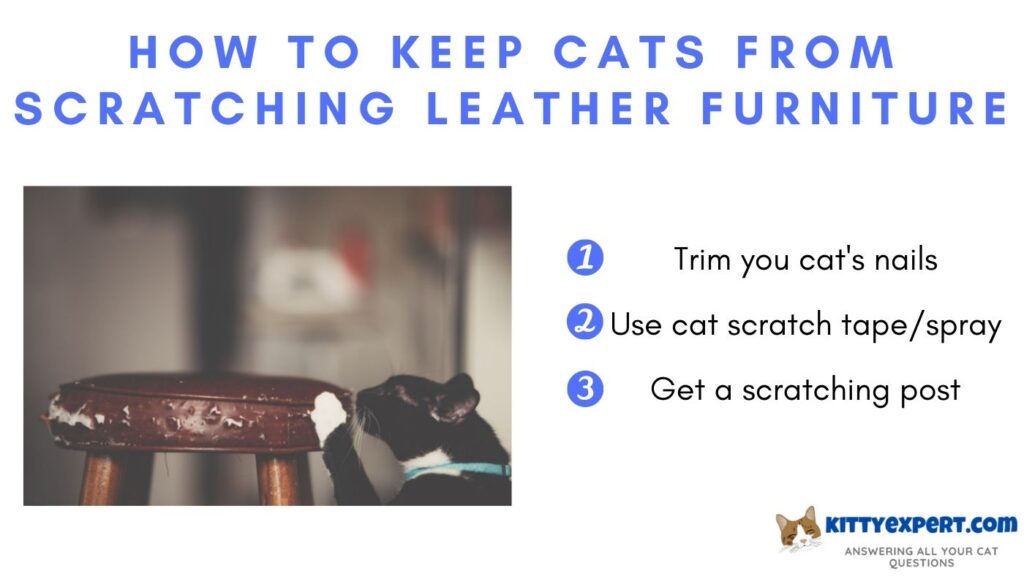All cat owners love their cats, but they can certainly get on your nerves when they scratch leather furniture. It’s common for cats to scratch leather household objects including couches, beds, chairs – the list goes on. You’ve probably already wondered why your cat seems to love etching their little works of art onto your furniture. Don’t worry, there’s no malice involved.
By understanding the reasoning behind the scratching, you can begin to understand how to keep your cats from scratching leather furniture.
How Do You Keep Your Cat From Scratching Leather Furniture?
To keep your cat from scratching leather furniture, you should keep your cat’s nails trimmed, make the furniture less appealing, and provide scratching posts.
Keep your cat’s nails trimmed
Whether it’s a British Shorthair for sale you’re looking at or you’re looking to adopt an older Abyssinian, setting a regular nail-trimming schedule is a great way to keep your cat’s scratching behavior under control. Most cats will start scratching at around eight weeks old, so starting young is a good idea. It may be more challenging to get mature cats to sit still as you clip their nails, so a trip to the groomer may help get them used to it. Once they’re more comfortable, you can attempt to do it yourself. A nail trim every two to three weeks works for most cat owners.
Make the furniture less appealing
There are a couple of methods to make your furniture a less-than-ideal place for your cats to scratch.
- Apply cat scratch tape – You can use either cat scratch tape or double-sided tape. Most cats find sticky surfaces annoying, so it’s a good deterrent to scratching. However, this solution may not be viable for surfaces that aren’t smooth, such as couches and other upholstered furniture.
- Apply a cat scratch spray – There are both commercial and homemade versions of cat scratch spray. Most are meant to make the cat think that they’ve already put their scent on the object that’s been sprayed. This method takes some time to be effective, as you’ll have to use the spray daily until the cat stops scratching. However, you should spray a small portion of the leather furniture first to make sure it doesn’t stain.
- Apply vinyl paneling – This is the drastic option for cats that simply won’t stop scratching. Vinyl panels are no longer a deterrent, they’re protection for your furniture. Panels of various sizes are available, and most screw on to your furniture.
Provide scratching posts
Most cats will scratch objects if they’re suitable for scratching. You can place scratching posts scattered around the house near furniture they usually scratch. Take note of the types of surfaces that your cat enjoys scratching. Scratching posts are made of various materials, and it should be possible to find some that match your cat’s preferred type of furniture.
Sometimes it takes a little coaxing to get your cat to use the scratching post instead of the furniture. Positive reinforcement is a good way to get them to use the post – whenever they pay attention to the post instead of the furniture, give them praise and a reward. Another method is to sprinkle some catnip around and on the post itself. Some cat owners have had success with playing with a wand toy near the post, then directing the cat’s attention to the post once they’ve started chasing the wand toy.
If your cat damages your furniture very bad, you can use olive oil to repair cat scratches.
Why Do Cats Scratch Leather?
Scratching and clawing at objects is simply something that all cats do. If you watch big cats such as lions, tigers, and jaguars, they also love to scratch. They just don’t do it on household furniture but on trees. Cats scratch to:
- Keep their claws healthy – Cat claws are made out of the same material as our fingernails, except theirs peels away in layers. A good scratching session is a way for the cat to remove the damaged outer layer and sharpen the claw.
- Mark their territory – Like many other predators, cats are territorial by nature. Scratching is a way for them to mark their territory, both visually and by scent. Whenever your cat scratches at an object, the scent glands in their paw pads release pheromones. These pheromones warn other animals that they are in the cat’s home turf.
- Stretch their bodies – Any cat owner knows that cats love stretching. Most scratching sessions are accompanied by a good stretch. Many cats will scratch while stretching, reaching far above or in front of themselves. Think of it as a human stretching while digging their toes into the carpet.
- Relieve boredom – Scratching is a good way of releasing excess physical or emotional energy. Female cats in heat may also be restless, and will tend to climb and scratch at things.
Let Your Cat Be A Cat
Let’s remember that scratching is a natural activity for cats. Most cats will need to scratch at least some of the time – so instead of looking to eliminate the behavior completely, it’s best to direct it to objects that are designed to be scratched such as cat furniture and scratchers. If your cat has moved on from furniture to the walls, we have an article on how to stop cats from scratching walls as well.

